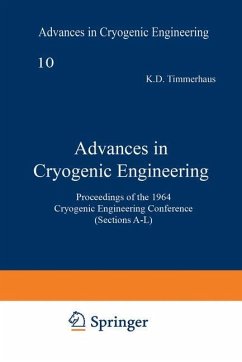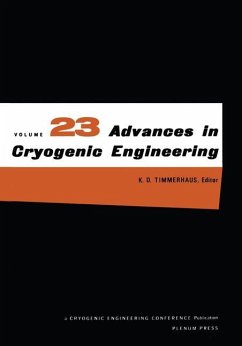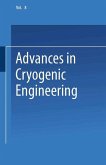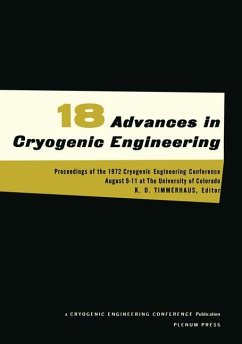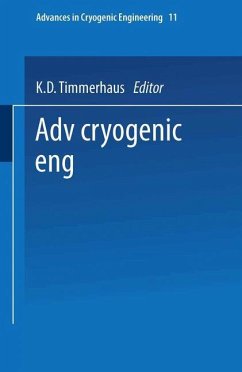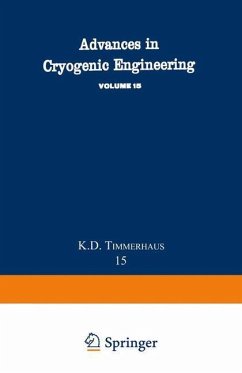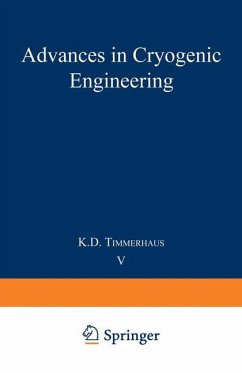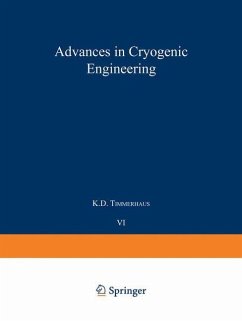Klaus D. Timmerhaus
Advances in Cryogenic Engineering
Proceedings of the 1964 Cryogenic Engineering Conference (Sections A¿L)
Klaus D. Timmerhaus
Advances in Cryogenic Engineering
Proceedings of the 1964 Cryogenic Engineering Conference (Sections A¿L)
- Broschiertes Buch
- Merkliste
- Auf die Merkliste
- Bewerten Bewerten
- Teilen
- Produkt teilen
- Produkterinnerung
- Produkterinnerung
Support from the National Science Foundation has made it possible for the tenth annual Cryogenic Engineering Conference, hosted by the University of Pennsylvania and capably directed by K. R. Atkins and his staff, to emphasize the major international advances in cryogenic engineering. This specific emphasis resulted in a final program of over one hundred papers and has made it necessary to publish the proceedings of the conference in two volumes. The first volume will be similar in nature to previous volumes in this series, while the second volume will feature the international aspect of the…mehr
Andere Kunden interessierten sich auch für
![Advances in Cryogenic Engineering Advances in Cryogenic Engineering]() Advances in Cryogenic Engineering40,99 €
Advances in Cryogenic Engineering40,99 €![Advances in Cryogenic Engineering Advances in Cryogenic Engineering]() K. D. TimmerhausAdvances in Cryogenic Engineering75,99 €
K. D. TimmerhausAdvances in Cryogenic Engineering75,99 €![Advances in Cryogenic Engineering Advances in Cryogenic Engineering]() Klaus D. TimmerhausAdvances in Cryogenic Engineering78,99 €
Klaus D. TimmerhausAdvances in Cryogenic Engineering78,99 €![Advances in Cryogenic Engineering Advances in Cryogenic Engineering]() Klaus D. TimmerhausAdvances in Cryogenic Engineering39,99 €
Klaus D. TimmerhausAdvances in Cryogenic Engineering39,99 €![Advances in Cryogenic Engineering Advances in Cryogenic Engineering]() Klaus D. TimmerhausAdvances in Cryogenic Engineering38,99 €
Klaus D. TimmerhausAdvances in Cryogenic Engineering38,99 €![Advances in Cryogenic Engineering Advances in Cryogenic Engineering]() Klaus D. TimmerhausAdvances in Cryogenic Engineering38,99 €
Klaus D. TimmerhausAdvances in Cryogenic Engineering38,99 €![Advances in Cryogenic Engineering Advances in Cryogenic Engineering]() Klaus D. TimmerhausAdvances in Cryogenic Engineering76,99 €
Klaus D. TimmerhausAdvances in Cryogenic Engineering76,99 €-
-
-
Support from the National Science Foundation has made it possible for the tenth annual Cryogenic Engineering Conference, hosted by the University of Pennsylvania and capably directed by K. R. Atkins and his staff, to emphasize the major international advances in cryogenic engineering. This specific emphasis resulted in a final program of over one hundred papers and has made it necessary to publish the proceedings of the conference in two volumes. The first volume will be similar in nature to previous volumes in this series, while the second volume will feature the international aspect of the conference program. The latter volume, because of this distinction, will be entitled International Advances in Cryogenic Engineering. As in the past, the Cryogenic Engineering Conference Committee gratefully acknow ledges the assistance of all the dedicated workers in the cryogenic field who have contributed their time in reviewing the preliminary papers for the program and the final manuscripts for this volume. Since the list of participants in this thankless task numbers well over one hundred, any attempt to acknowledge their individual contributions in the limited space available would be practically impossible.
Hinweis: Dieser Artikel kann nur an eine deutsche Lieferadresse ausgeliefert werden.
Hinweis: Dieser Artikel kann nur an eine deutsche Lieferadresse ausgeliefert werden.
Produktdetails
- Produktdetails
- Advances in Cryogenic Engineering .10
- Verlag: Springer / Springer US / Springer, Berlin
- Softcover reprint of the original 1st ed. 1965
- Seitenzahl: 528
- Erscheinungstermin: 22. Dezember 2012
- Englisch
- Abmessung: 254mm x 178mm x 29mm
- Gewicht: 994g
- ISBN-13: 9781468431100
- ISBN-10: 1468431102
- Artikelnr.: 40768548
- Herstellerkennzeichnung
- Springer-Verlag GmbH
- Tiergartenstr. 17
- 69121 Heidelberg
- ProductSafety@springernature.com
- Advances in Cryogenic Engineering .10
- Verlag: Springer / Springer US / Springer, Berlin
- Softcover reprint of the original 1st ed. 1965
- Seitenzahl: 528
- Erscheinungstermin: 22. Dezember 2012
- Englisch
- Abmessung: 254mm x 178mm x 29mm
- Gewicht: 994g
- ISBN-13: 9781468431100
- ISBN-10: 1468431102
- Artikelnr.: 40768548
- Herstellerkennzeichnung
- Springer-Verlag GmbH
- Tiergartenstr. 17
- 69121 Heidelberg
- ProductSafety@springernature.com
Metallic Materials Behavior.- A-1 Fatigue Behavior of Aluminum and Titanium Sheet Materials Down to -423°F.- A-2 Cryogenic Tensile Properties of Selected Aerospace Materials.- A-3 Evaluation of Stainless Steel Casting Alloys for Cryogenic Service in the 80-Inch Liquid-Hydrogen Bubble Chamber.- A-4 Metallurgical Evaluation of a New Aluminum Casting Alloy Developed for Space Vehicle Use at Cryogenic Temperatures.- A-5 An Anomalous Decrease of the Elastic Moduli at Very Low Temperatures in Some 300 Series Stainless Steels.- A-6 Shear Strength of Several Alloys at Liquid-Hydrogen Temperatures.- A-7 Charpy Impact Testing at 20°K.- A-8 Mechanical Properties of Several 2000 and 6000 Series Aluminum Alloys.- Metallic Materials-Flow and Fracture.- B-1 Evaluation of Fracture Characteristics of Aluminum Alloys at Cryogenic Temperatures.- B-2 Evaluation of the Effects of Specimen Configuration and Testing Variables on Crack Propagation Properties.- B-3 Low-Temperature Flow and Fracture Behavior of Tantalum.- B-4 Creep Properties of 18-10 and 25-20 Stainless Steels at Cryogenic Temperatures.- Nonmetallic Materials Behavior.- C-1 Mechanical Properties Testing of Plastic Laminate Materials Down to 20°K.- C-2 An Assessment of Test Specimens and Test Techniques Useful to the Evaluation of Structural Reinforced Plastic Materials at Cryogenic Temperatures.- C-3 Structural Properties of Glass-Fiber Filament-Wound Cryogenic Pressure Vessels.- C-4 The Development of a New Cryogenic Gasket for Liquid-Oxygen Service.- C-5 Thermal Expansion Characteristics of Some Plastic Materials and Composites from Room Temperature to - 253°C.- C-6 Thermal Conductivity of Reinforced Plastics at Cryogenic Temperatures.- C-7 Low-Temperature Tensile, Thermal Contraction, and Gaseous HydrogenPermeability Data on Hydrogen-Vapor Barrier Materials.- Ortho-Parahydrogen Catalysis.- D-1 Improved Ferric Oxide Gel Catalysts for Ortho-Parahydrogen Conversion.- D-2 Experimental Study of Reaction Kinetics for Para-Orthohydrogen at 20° to 80°K.- Insulation.- E-l Multishielding-An Advanced Superinsulation Technique.- E-2 Practical Problems in Design of High-Performance Multilayer Insulation System for Cryogenic Stages.- E-3 Development of a Lightweight External Insulation System for Liquid-Hydrogen Stages of the Saturn V Vehicle.- E-4 Thermal and Pressure-Induced Strains in Internal Cryogenic Insulations.- Instrumentation.- F-1 Dilute Gold-Iron Thermoelements in Low-Temperature Thermocouples.- F-2 A Novel Principle for the Measurement of Low Temperature.- F-3 Considerations When Using Turbine-Type Flowmeters in Cryogenic Service.- F-4 A Single-Channel, Multipoint, Continuous, Liquid-Level System for Liquid Hydrogen, Using Carbon Resistors.- Safety.- G-1 A Combustion Test Program to Establish Design Criteria for Liquid-Hydrogen-Fueled Space Vehicles.- G-2 Spark Ignition Parameters of Cryogenic Hydrogen in Oxygen and Nitrogen Mixtures.- G-3 Large Volume Operational Room Inerting.- G-4 Catalysis Poisons for Platinum-Wire Liquid-Level Sensors.- Cryopumping.- H-1 Capture Coefficients of Gases at 77°K.- H-2 Obtaining Low Pressures with Cryosorption Pumps.- Fluid Phenomena.- I-1 A Technique for the Simulation of Thermal Behavior of Fluids in a Low-Gravity Field.- I-2 Probing Experiments on Pressure Oscillations in Two-Phase and Supercritical Hydrogen with Forced Convection Heat Transfer.- I-3 Transfer Line Surge.- I-4 Detection of Density Variations in Flowing Two-Phase Hydrogen.- I-5 Cool-Down Temperatures and Cool-Down Time During Mist Flow.- I-6 Analytical andExperimental Investigation of Thermal and Helium Lift-Pumping Recirculation Systems.- I-7 An Experimental Investigation of Geysering in Vertical Tubes.- I-8 An Experimental Evaluation of the Performance of Cryogenic Gaseous Hydrogen as a Monopropellant.- I-9 Pressure Drop Considerations in the Transfer of Fluids.- Equipment Development.- J-1 Experimental Study of H2O-LH2 and H2O-LN2 Heat Exchangers.- J-2 Expulsion Bladders for Cryogenic Liquids.- J-3 A Versatile Low-Temperature Probe for Application to Cryosurgery.- J-4 Simple Technique for the Ultrapurification of Helium.- J-5 A Nitrogen Supply System for Post-Run Cooldown of Nuclear Reactors.- J-6 Development and Design of a 100-lb/sec Liquid-Air Vaporizer.- J-7 Mobile Nitrogen Transport and High-Pressure Pumping Equipment for Oil Well Servicing.- J-8 Supercritical Pressure Customer Station.- J-9 A Large-Scale Storage and Transfer System for Distribution of Liquid Helium as a Refrigerant Medium.- J-10 Efficiency of Low-Temperature Expansion Machines.- Seals.- K-1 Large-Diameter Metal Seals for Nuclear Rocket Applications.- K-2 A New Vacuum-Insulated Cryogenic Coupling.- K-3 A Rotatable Sealing Coupling for Cryogenic Uses.- K-4 A New Positive Seal for Pistons and Axially Moving Rods.- Miniature Refrigerators.- L-1 Continuous Cryogenic Refrigeration for Three to Five Micron Infrared.- L-2 A Cryogenic Refrigerator for Long-Life Applications in Satellites.- L-3 Conduction Cooling of a Traveling Wave Maser Superconducting Magnet in a Closed-Cycle Refrigerator.- L-4 The Feasibility of Solid-State Cryogenic Refrigeration to 70°K.- Indexes.- Author Index.
Metallic Materials Behavior.- A-1 Fatigue Behavior of Aluminum and Titanium Sheet Materials Down to -423°F.- A-2 Cryogenic Tensile Properties of Selected Aerospace Materials.- A-3 Evaluation of Stainless Steel Casting Alloys for Cryogenic Service in the 80-Inch Liquid-Hydrogen Bubble Chamber.- A-4 Metallurgical Evaluation of a New Aluminum Casting Alloy Developed for Space Vehicle Use at Cryogenic Temperatures.- A-5 An Anomalous Decrease of the Elastic Moduli at Very Low Temperatures in Some 300 Series Stainless Steels.- A-6 Shear Strength of Several Alloys at Liquid-Hydrogen Temperatures.- A-7 Charpy Impact Testing at 20°K.- A-8 Mechanical Properties of Several 2000 and 6000 Series Aluminum Alloys.- Metallic Materials-Flow and Fracture.- B-1 Evaluation of Fracture Characteristics of Aluminum Alloys at Cryogenic Temperatures.- B-2 Evaluation of the Effects of Specimen Configuration and Testing Variables on Crack Propagation Properties.- B-3 Low-Temperature Flow and Fracture Behavior of Tantalum.- B-4 Creep Properties of 18-10 and 25-20 Stainless Steels at Cryogenic Temperatures.- Nonmetallic Materials Behavior.- C-1 Mechanical Properties Testing of Plastic Laminate Materials Down to 20°K.- C-2 An Assessment of Test Specimens and Test Techniques Useful to the Evaluation of Structural Reinforced Plastic Materials at Cryogenic Temperatures.- C-3 Structural Properties of Glass-Fiber Filament-Wound Cryogenic Pressure Vessels.- C-4 The Development of a New Cryogenic Gasket for Liquid-Oxygen Service.- C-5 Thermal Expansion Characteristics of Some Plastic Materials and Composites from Room Temperature to - 253°C.- C-6 Thermal Conductivity of Reinforced Plastics at Cryogenic Temperatures.- C-7 Low-Temperature Tensile, Thermal Contraction, and Gaseous HydrogenPermeability Data on Hydrogen-Vapor Barrier Materials.- Ortho-Parahydrogen Catalysis.- D-1 Improved Ferric Oxide Gel Catalysts for Ortho-Parahydrogen Conversion.- D-2 Experimental Study of Reaction Kinetics for Para-Orthohydrogen at 20° to 80°K.- Insulation.- E-l Multishielding-An Advanced Superinsulation Technique.- E-2 Practical Problems in Design of High-Performance Multilayer Insulation System for Cryogenic Stages.- E-3 Development of a Lightweight External Insulation System for Liquid-Hydrogen Stages of the Saturn V Vehicle.- E-4 Thermal and Pressure-Induced Strains in Internal Cryogenic Insulations.- Instrumentation.- F-1 Dilute Gold-Iron Thermoelements in Low-Temperature Thermocouples.- F-2 A Novel Principle for the Measurement of Low Temperature.- F-3 Considerations When Using Turbine-Type Flowmeters in Cryogenic Service.- F-4 A Single-Channel, Multipoint, Continuous, Liquid-Level System for Liquid Hydrogen, Using Carbon Resistors.- Safety.- G-1 A Combustion Test Program to Establish Design Criteria for Liquid-Hydrogen-Fueled Space Vehicles.- G-2 Spark Ignition Parameters of Cryogenic Hydrogen in Oxygen and Nitrogen Mixtures.- G-3 Large Volume Operational Room Inerting.- G-4 Catalysis Poisons for Platinum-Wire Liquid-Level Sensors.- Cryopumping.- H-1 Capture Coefficients of Gases at 77°K.- H-2 Obtaining Low Pressures with Cryosorption Pumps.- Fluid Phenomena.- I-1 A Technique for the Simulation of Thermal Behavior of Fluids in a Low-Gravity Field.- I-2 Probing Experiments on Pressure Oscillations in Two-Phase and Supercritical Hydrogen with Forced Convection Heat Transfer.- I-3 Transfer Line Surge.- I-4 Detection of Density Variations in Flowing Two-Phase Hydrogen.- I-5 Cool-Down Temperatures and Cool-Down Time During Mist Flow.- I-6 Analytical andExperimental Investigation of Thermal and Helium Lift-Pumping Recirculation Systems.- I-7 An Experimental Investigation of Geysering in Vertical Tubes.- I-8 An Experimental Evaluation of the Performance of Cryogenic Gaseous Hydrogen as a Monopropellant.- I-9 Pressure Drop Considerations in the Transfer of Fluids.- Equipment Development.- J-1 Experimental Study of H2O-LH2 and H2O-LN2 Heat Exchangers.- J-2 Expulsion Bladders for Cryogenic Liquids.- J-3 A Versatile Low-Temperature Probe for Application to Cryosurgery.- J-4 Simple Technique for the Ultrapurification of Helium.- J-5 A Nitrogen Supply System for Post-Run Cooldown of Nuclear Reactors.- J-6 Development and Design of a 100-lb/sec Liquid-Air Vaporizer.- J-7 Mobile Nitrogen Transport and High-Pressure Pumping Equipment for Oil Well Servicing.- J-8 Supercritical Pressure Customer Station.- J-9 A Large-Scale Storage and Transfer System for Distribution of Liquid Helium as a Refrigerant Medium.- J-10 Efficiency of Low-Temperature Expansion Machines.- Seals.- K-1 Large-Diameter Metal Seals for Nuclear Rocket Applications.- K-2 A New Vacuum-Insulated Cryogenic Coupling.- K-3 A Rotatable Sealing Coupling for Cryogenic Uses.- K-4 A New Positive Seal for Pistons and Axially Moving Rods.- Miniature Refrigerators.- L-1 Continuous Cryogenic Refrigeration for Three to Five Micron Infrared.- L-2 A Cryogenic Refrigerator for Long-Life Applications in Satellites.- L-3 Conduction Cooling of a Traveling Wave Maser Superconducting Magnet in a Closed-Cycle Refrigerator.- L-4 The Feasibility of Solid-State Cryogenic Refrigeration to 70°K.- Indexes.- Author Index.

